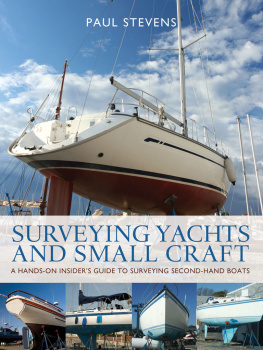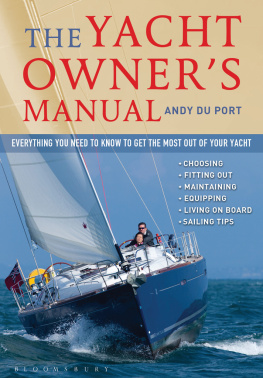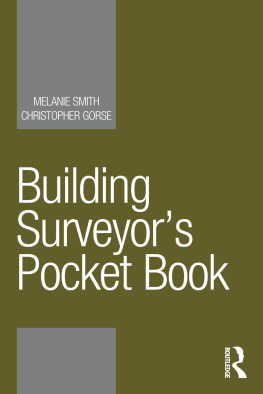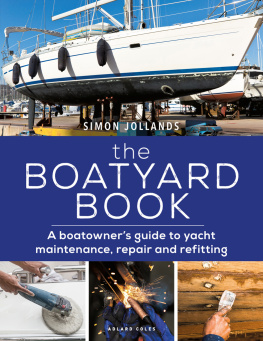
Dedication
This book is dedicated to my two wonderful sons, Jono and Simon, without whose constant badgering I would never have completed it.
Acknowledgements
This book grew out of the practical surveying courses I have run at the International Boatbuilding Training College Lowestoft, and those courses would not have been possible without the support of Foxs Marina and Foxs Yacht Sales of Ipswich.
I should also like to thank my good friend William Walsh, surveyor of Athens, who first suggested I write this book and refused to let the matter drop till I did.
This book is not a dissertation on the world of yacht and small craft surveying. Nor is it a mere repetition of the various mandatory standards or voluntary codes of practice that apply to these vessels - a few hours online will readily turn up a plethora of information in that respect. No, this is essentially a highly illustrated doing book that grew out of the practical yacht and small craft survey courses I run at the International Boatbuilding Training College Lowestoft, www.ibtc.co.uk.
If you are going equipped to survey, what do you actually do when you turn up on site? Where do you start? What tools will you need? What sort of defects are you likely to find? What do they look like? How do you quantify them? How do you record the information as you work? How do you write the subsequent survey report? All these questions and more are answered in the following pages.
This book will appeal to those contemplating a career in surveying and perhaps pursuing one of the predominantly theory-based distance learning courses, but will also be invaluable for anyone proposing to buy or sell a second-hand boat. With the help of this book, as a potential buyer you will be able to carry out your own pre-survey inspections and rule out unsound or badly maintained vessels at an early stage. It will also appeal to those boat owners who would like to understand their vessels better and be able to recognise potential defects in a timely manner, perhaps in preparation for placing the vessel on the market. Well prepared boats will always sell ahead of lesser examples.
So what is a small craft surveyor? Above all he is an assessor of condition, and although he may be many other things such as a naval architect, marine engineer, master mariner, boatbuilder, experienced yachtsman, boat owner etc, his primary function is to find defects and subsequently put them into context. His additional experience in related fields will be useful in this process but unless he can detect and quantify defects he will fall at the first hurdle. This book is thus not overly technical, concentrating instead on detecting and understanding defects.
Wherever I refer to he in this book I mean he or she. Surveying has traditionally been a male preserve, however this is changing. At the time of writing 25% of the delegates on the current IBTC training course are women and they are not the first to have completed the course. The collective noun for a group of surveyors is an argument. So I do not claim that the methods described in this book are the only ones worthy of consideration. What I can claim, however, is that the methods described here have enabled me to enjoy a successful career in the field I love.
ABYC | American Boat and Yacht Council |
Ah | Amp-hour rating, the capacity of a battery |
BMC | British Motor Corporation |
BMSE | British Marine Surveyors Europe |
BSEN | British Standard European Norm |
BSS | Boat Safety Scheme |
CE (marking) | CE marking is a declaration by the manufacturer that the product meets all the appropriate provisions of the relevant legislation, implementing certain European Directives |
CORGI | Now the Gas Safe Register, the body for ensuring high standards of gas appliance and installation work |
DZR | Dezincification Resistant Brass |
FRP | Fibre Reinforced Plastic |
GRP | Glass Reinforced Plastic |
HCC | Hull Construction Certificate |
HIN | Hull Identification Number |
IIMS | International Institute of Marine Surveying |
IMEST | Institute of Marine Engineering Science and Technology |
ISO | International Standards Organisation |
LPG | Liquefied Petroleum Gas |
MCA | Maritime and Coastguard Agency |
PI | Professional Indemnity Insurance |
RCD | Recreational Craft Directive |
RINA | Royal Institute of Naval Architects |
RNLI | Royal National Lifeboat Institution |
RYA | Royal Yachting Association |
SSR | Small Ships Register |
UV | Ultraviolet |
VHF | VHF radio |
YDSA | Yacht Designers and Surveyors Association |
Before we turn to practical matters it is necessary to take a brief look at the yacht and small craft survey scene and the various bodies involved in it. The following is only a brief outline but extensive additional information is available online.
The following are mandatory:
This is an EU wide standard. It is a CE marking directive which sets out a uniform level of safety in the design and manufacture of recreational craft throughout the European Economic Area. It covers craft for sporting and recreational purposes with hull lengths between 2.5 and 24 metres as well as certain items of equipment. All recreational vessels placed on the market in the European Economic Area and built 15 June 1998 onwards would normally comply with this legislation, and the penalties for not doing so are severe. The standard also applies to non-compliant craft entering the EU and being placed on the market after the above date. A few vessels are exempt or excluded and we will look at these later in the survey checklist section of the book.
The directive also lays out requirements for type testing and quality control procedures. The protection requirements are dealt with in depth and organised under 30 headings. The directive contains both administrative and protective requirements for recreational craft. The administrative requirements include marking with a CE plate, which defines the category in which the vessel has been placed. These categories set out the maximum wind strength and wave height in which the vessel should be operated, number of persons carried etc and have become a kind of benchmark to express the vessels capabilities. Every vessel must also have a declaration of conformity and a technical file.
Next page

















